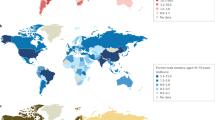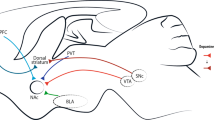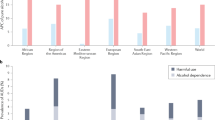Abstract
The World Health Organization estimates that one-third of the global adult population smokes. Because tobacco use is on the rise in developing countries, death resulting from tobacco use continues to rise. Nicotine, the main addictive component of tobacco, initiates synaptic and cellular changes that underlie the motivational and behavioral alterations that culminate in addiction. Nicotine addiction progresses rapidly in adolescents and is most highly expressed in vulnerable people who have psychiatric illness or other substance abuse problems.
This is a preview of subscription content, access via your institution
Access options
Subscribe to this journal
Receive 12 print issues and online access
$209.00 per year
only $17.42 per issue
Buy this article
- Purchase on Springer Link
- Instant access to full article PDF
Prices may be subject to local taxes which are calculated during checkout

Similar content being viewed by others
References
Peto, R., Lopez, A.D., Boreham, J., Thun, M. & Heath, C., Jr. Mortality from tobacco in developed countries: indirect estimation from national vital statistics. Lancet 339, 1268–1278 (1992).
Tobacco or Health: A Global Status Report (World Health Organization, Geneva, 1997).
Epping-Jordan, M.P., Watkins, S.S., Koob, G.F. & Markou, A. Dramatic decreases in brain reward function during nicotine withdrawal. Nature 393, 76–79 (1998).
Balfour, D.J. The neurobiology of tobacco dependence: a preclinical perspective on the role of the dopamine projections to the nucleus. Nicotine Tob. Res. 6, 899–912 (2004).
Benowitz, N.L. Nicotine addiction. Prim. Care 26, 611–631 (1999).
Karan, L., Dani, J.D. & Benowitz, N. The pharmacology of nicotine and tobacco. in Principles of Addiction Medicine 3rd Ed., 225–248 (American Society of Addiction Medicine, Chevy Chase, Maryland, 2003).
Dani, J.A. & Heinemann, S. Molecular and cellular aspects of nicotine abuse. Neuron 16, 905–908 (1996).
Di Chiara, G. Role of dopamine in the behavioural actions of nicotine related to addiction. Eur. J. Pharmacol. 393, 295–314 (2000).
Di Chiara, G. et al. Dopamine and drug addiction: the nucleus accumbens shell connection. Neuropharmacology 47 (Suppl.) 227–241 (2004).
Mansvelder, H.D. & McGehee, D.S. Cellular and synaptic mechanisms of nicotine addiction. J. Neurobiol. 53, 606–617 (2002).
Stolerman, I.P. & Shoaib, M. The neurobiology of tobacco addiction. Trends Pharmacol. Sci. 12, 467–473 (1991).
Grant, B.F., Hasin, D.S., Chou, S.P., Stinson, F.S. & Dawson, D.A. Nicotine dependence and psychiatric disorders in the United States: results from the national epidemiologic survey on alcohol and related conditions. Arch. Gen. Psychiatry 61, 1107–1115 (2004).
Leonard, S. et al. Smoking and mental illness. Pharmacol. Biochem. Behav. 70, 561–570 (2001).
Quattrocki, E., Baird, A. & Yurgelun-Todd, D. Biological aspects of the link between smoking and depression. Harv. Rev. Psychiatry 8, 99–110 (2000).
Henningfield, J.E., Moolchan, E.T. & Zeller, M. Regulatory strategies to reduce tobacco addiction in youth. Tob. Control 12 (Suppl.) i14–i24 (2003).
DiFranza, J.R. et al. Initial symptoms of nicotine dependence in adolescents. Tob. Control 9, 313–319 (2000).
Jones, S. & Bonci, A. Synaptic plasticity and drug addiction. Curr. Opin. Pharmacol. 5, 20–25 (2005).
Mansvelder, H.D. & McGehee, D.S. Long-term potentiation of excitatory inputs to brain reward areas by nicotine. Neuron 27, 349–357 (2000).
Levin, E.D., Rezvani, A.H., Montoya, D., Rose, J.E. & Swartzwelder, H.S. Adolescent-onset nicotine self-administration modeled in female rats. Psychopharmacology (Berl.) 169, 141–149 (2003).
Vastola, B.J., Douglas, L.A., Varlinskaya, E.I. & Spear, L.P. Nicotine-induced conditioned place preference in adolescent and adult rats. Physiol. Behav. 77, 107–114 (2002).
Laviolette, S.R. & van der Kooy, D. Blockade of mesolimbic dopamine transmission dramatically increases sensitivity to the rewarding effects of nicotine in the ventral tegmental area. Mol. Psychiatry 8, 50–59 (2003).
Laviolette, S.R. & van der Kooy, D. The neurobiology of nicotine addiction: bridging the gap from molecules to behaviour. Nat. Rev. Neurosci. 5, 55–65 (2004).
Wonnacott, S., Sidhpura, N. & Balfour, D.J. Nicotine: from molecular mechanisms to behaviour. Curr. Opin. Pharmacol. 5, 53–59 (2005).
Adriani, W. et al. Evidence for enhanced neurobehavioral vulnerability to nicotine during periadolescence in rats. J. Neurosci. 23, 4712–4716 (2003).
Jones, S., Sudweeks, S. & Yakel, J.L. Nicotinic receptors in the brain: correlating physiology with function. Trends Neurosci. 22, 555–561 (1999).
Role, L.W. & Berg, D.K. Nicotinic receptors in the development and modulation of CNS synapses. Neuron 16, 1077–1085 (1996).
Picciotto, M.R. & Corrigall, W.A. Neuronal systems underlying behaviors related to nicotine addiction: neural circuits and molecular genetics. J. Neurosci. 22, 3338–3341 (2002).
Corrigall, W.A. Nicotine self-administration in animals as a dependence model. Nicotine Tob. Res. 1, 11–20 (1999).
Dani, J.A., Ji, D. & Zhou, F.M. Synaptic plasticity and nicotine addiction. Neuron 31, 349–352 (2001).
Schultz, W., Dayan, P. & Montague, P.R. A neural substrate of prediction and reward. Science 275, 1593–1599 (1997).
Rose, J.E., Behm, F.M., Westman, E.C. & Coleman, R.E. Arterial nicotine kinetics during cigarette smoking and intravenous nicotine administration: implications for addiction. Drug Alcohol Depend. 56, 99–107 (1999).
Pidoplichko, V.I., DeBiasi, M., Williams, J.T. & Dani, J.A. Nicotine activates and desensitizes midbrain dopamine neurons. Nature 390, 401–404 (1997).
Schilstrom, B., Nomikos, G.G., Nisell, M., Hertel, P. & Svensson, T.H. N-methyl-D-aspartate receptor antagonism in the ventral tegmental area diminishes the systemic nicotine-induced dopamine release in the nucleus accumbens. Neuroscience 82, 781–789 (1998).
Schilstrom, B., Rawal, N., Mameli-Engvall, M., Nomikos, G.G. & Svensson, T.H. Dual effects of nicotine on dopamine neurons mediated by different nicotinic receptor subtypes. Int. J. Neuropsychopharmacol. 6, 1–11 (2003).
Tapper, A.R. et al. Nicotine activation of alpha4* receptors: sufficient for reward, tolerance, and sensitization. Science 306, 1029–1032 (2004).
Picciotto, M.R. et al. Acetylcholine receptors containing the beta2 subunit are involved in the reinforcing properties of nicotine. Nature 391, 173–177 (1998).
Maskos, U. et al. Nicotine reinforcement and cognition restored by targeted expression of nicotinic receptors. Nature 436, 103–107 (2005).
Klink, R., de Kerchove d'Exaerde, A., Zoli, M. & Changeux, J.P. Molecular and physiological diversity of nicotinic acetylcholine receptors in the midbrain dopaminergic nuclei. J. Neurosci. 21, 1452–1463 (2001).
Wooltorton, J.R., Pidoplichko, V.I., Broide, R.S. & Dani, J.A. Differential desensitization and distribution of nicotinic acetylcholine receptor subtypes in midbrain dopamine areas. J. Neurosci. 23, 3176–3185 (2003).
Pidoplichko, V.I. et al. Nicotinic cholinergic synaptic mechanisms in the ventral tegmental area contribute to nicotine addiction. Learn. Mem. 11, 60–69 (2004).
Carr, D.B. & Sesack, S.R. Projections from the rat prefrontal cortex to the ventral tegmental area: target specificity in the synaptic associations with mesoaccumbens and mesocortical neurons. J. Neurosci. 20, 3864–3873 (2000).
Omelchenko, N. & Sesack, S.R. Laterodorsal tegmental projections to identified cell populations in the rat ventral tegmental area. J. Comp. Neurol. 483, 217–235 (2005).
Lanca, A.J., Adamson, K.L., Coen, K.M., Chow, B.L. & Corrigall, W.A. The pedunculopontine tegmental nucleus and the role of cholinergic neurons in nicotine self-administration in the rat: a correlative neuroanatomical and behavioral study. Neuroscience 96, 735–742 (2000).
Malenka, R.C. & Nicoll, R.A. Long-term potentiation–a decade of progress? Science 285, 1870–1874 (1999).
Garzon, M., Vaughan, R.A., Uhl, G.R., Kuhar, M.J. & Pickel, V.M. Cholinergic axon terminals in the ventral tegmental area target a subpopulation of neurons expressing low levels of the dopamine transporter. J. Comp. Neurol. 410, 197–210 (1999).
Mansvelder, H.D., Keath, J.R. & McGehee, D.S. Synaptic mechanisms underlie nicotine-induced excitability of brain reward areas. Neuron 33, 905–919 (2002).
Salminen, O. et al. Subunit composition and pharmacology of two classes of striatal presynaptic nicotinic acetylcholine receptors mediating dopamine release in mice. Mol. Pharmacol. 65, 1526–1535 (2004).
Zhang, H. & Sulzer, D. Frequency-dependent modulation of dopamine release by nicotine. Nat. Neurosci. 7, 581–582 (2004).
Zhou, F.M., Liang, Y. & Dani, J.A. Endogenous nicotinic cholinergic activity regulates dopamine release in the striatum. Nat. Neurosci. 4, 1224–1229 (2001).
Rice, M.E. & Cragg, S.J. Nicotine amplifies reward-related dopamine signals in striatum. Nat. Neurosci. 7, 583–584 (2004).
de Rover, M., Lodder, J.C., Kits, K.S., Schoffelmeer, A.N. & Brussaard, A.B. Cholinergic modulation of nucleus accumbens medium spiny neurons. Eur. J. Neurosci. 16, 2279–2290 (2002).
Mansvelder, H.D., De Rover, M., McGehee, D.S. & Brussaard, A.B. Cholinergic modulation of dopaminergic reward areas: upstream and downstream targets of nicotine addiction. Eur. J. Pharmacol. 480, 117–123 (2003).
Berrendero, F., Kieffer, B.L. & Maldonado, R. Attenuation of nicotine-induced antinociception, rewarding effects, and dependence in mu-opioid receptor knock-out mice. J. Neurosci. 22, 10935–10940 (2002).
Walters, C.L., Cleck, J.N., Kuo, Y.C. & Blendy, J.A. mu-opioid receptor and CREB activation are required for nicotine reward. Neuron 46, 933–943 (2005).
Nestler, E.J. Molecular mechanisms of drug addiction. Neuropharmacology 47 (suppl.) 24–32 (2004).
Nestler, E.J. Is there a common molecular pathway for addiction? Nat. Neurosci. 8, 1445–1449 (2005).
Kenny, P.J., Gasparini, F. & Markou, A. Group II metabotropic and alpha-amino-3-hydroxy-5-methyl-4-isoxazole propionate (AMPA)/kainate glutamate receptors regulate the deficit in brain reward function associated with nicotine withdrawal in rats. J. Pharmacol. Exp. Ther. 306, 1068–1076 (2003).
Kenny, P.J. & Markou, A. Conditioned nicotine withdrawal profoundly decreases the activity of brain reward systems. J. Neurosci. 25, 6208–6212 (2005).
Salas, R., Pieri, F. & De Biasi, M. Decreased signs of nicotine withdrawal in mice null for the beta4 nicotinic acetylcholine receptor subunit. J. Neurosci. 24, 10035–10039 (2004).
Kandel, D., Chen, K., Warner, L.A., Kessler, R.C. & Grant, B. Prevalence and demographic correlates of symptoms of last year dependence on alcohol, nicotine, marijuana and cocaine in the U.S. population. Drug Alcohol Depend. 44, 11–29 (1997).
Upadhyaya, H.P., Deas, D., Brady, K.T. & Kruesi, M. Cigarette smoking and psychiatric comorbidity in children and adolescents. J. Am. Acad. Child Adolesc. Psychiatry 41, 1294–1305 (2002).
Patton, G.C. et al. Depression, anxiety, and smoking initiation: a prospective study over 3 years. Am. J. Public Health 88, 1518–1522 (1998).
Kendler, K.S. et al. Smoking and major depression. A causal analysis. Arch. Gen. Psychiatry 50, 36–43 (1993).
Freedman, R. et al. Linkage disequilibrium for schizophrenia at the chromosome 15q13–14 locus of the alpha7-nicotinic acetylcholine receptor subunit gene (CHRNA7). Am. J. Med. Genet. 105, 20–22 (2001).
Harris, J.G. et al. Effects of nicotine on cognitive deficits in schizophrenia. Neuropsychopharmacology 29, 1378–1385 (2004).
Fowler, J.S. et al. Brain monoamine oxidase A inhibition in cigarette smokers. Proc. Natl. Acad. Sci. USA 93, 14065–14069 (1996).
Balfour, D.J. & Ridley, D.L. The effects of nicotine on neural pathways implicated in depression: a factor in nicotine addiction? Pharmacol. Biochem. Behav. 66, 79–85 (2000).
McEvoy, J.P. & Brown, S. Smoking in first-episode patients with schizophrenia. Am. J. Psychiatry 156, 1120–1121 (1999).
Goeders, N.E. Stress and cocaine addiction. J. Pharmacol. Exp. Ther. 301, 785–789 (2002).
Saal, D., Dong, Y., Bonci, A. & Malenka, R.C. Drugs of abuse and stress trigger a common synaptic adaptation in dopamine neurons. Neuron 37, 577–582 (2003).
Hughes, J.R., Higgins, S.T. & Bickel, W.K. Nicotine withdrawal versus other drug withdrawal syndromes: similarities and dissimilarities. Addiction 89, 1461–1470 (1994).
Hughes, J.R., Rose, G.L. & Callas, P.W. Nicotine is more reinforcing in smokers with a past history of alcoholism than in smokers without this history. Alcohol. Clin. Exp. Res. 24, 1633–1638 (2000).
Crabbe, J. & Lovinger, D.M. Animal models of alcoholism: treatment target identification and insight into mechanisms. Nat. Neurosci. 8, 1471–1480 (2005).
True, W.R. et al. Common genetic vulnerability for nicotine and alcohol dependence in men. Arch. Gen. Psychiatry 56, 655–661 (1999).
Madden, P.A., Heath, A.C., Starmer, G.A., Whitfield, J.B. & Martin, N.G. Alcohol sensitivity and smoking history in men and women. Alcohol. Clin. Exp. Res. 19, 1111–1120 (1995).
Schuckit, M.A. & Smith, T.L. Changes over time in the self-reported level of response to alcohol. Alcohol Alcohol. 39, 433–438 (2004).
Blednov, Y.A., Stoffel, M., Alva, H. & Harris, R.A. A pervasive mechanism for analgesia: activation of GIRK2 channels. Proc. Natl. Acad. Sci. USA 100, 277–282 (2003).
Lopez, M.F., White, N.M. & Randall, C.L. Alcohol tolerance and nicotine cross-tolerance in adolescent mice. Addict. Biol. 6, 119–127 (2001).
Staley, J.K. et al. Cortical gamma-aminobutyric acid type A-benzodiazepine receptors in recovery from alcohol dependence: relationship to features of alcohol dependence and cigarette smoking. Arch. Gen. Psychiatry 62, 877–888 (2005).
John, U., Meyer, C., Rumpf, H.J. & Hapke, U. Probabilities of alcohol high-risk drinking, abuse or dependence estimated on grounds of tobacco smoking and nicotine dependence. Addiction 98, 805–814 (2003).
Riala, K., Hakko, H., Isohanni, M., Jarvelin, M.R. & Rasanen, P. Teenage smoking and substance use as predictors of severe alcohol problems in late adolescence and in young adulthood. J. Adolesc. Health 35, 245–254 (2004).
Clark, A., Lindgren, S., Brooks, S.P., Watson, W.P. & Little, H.J. Chronic infusion of nicotine can increase operant self-administration of alcohol. Neuropharmacology 41, 108–117 (2001).
De Fiebre, C.M., Medhurst, L.J. & Collins, A.C. Nicotine response and nicotinic receptors in long-sleep and short-sleep mice. Alcohol 4, 493–501 (1987).
de Fiebre, N.C., Dawson, R., Jr. & de Fiebre, C.M. The selectively bred high alcohol sensitivity (HAS) and low alcohol sensitivity (LAS) rats differ in sensitivity to nicotine. Alcohol. Clin. Exp. Res. 26, 765–772 (2002).
Owens, J.C. et al. Alpha 4 beta 2* nicotinic acetylcholine receptors modulate the effects of ethanol and nicotine on the acoustic startle response. Alcohol. Clin. Exp. Res. 27, 1867–1875 (2003).
Butt, C.M., King, N.M., Stitzel, J.A. & Collins, A.C. Interaction of the nicotinic cholinergic system with ethanol withdrawal. J. Pharmacol. Exp. Ther. 308, 591–599 (2004).
Borghese, C.M., Henderson, L.A., Bleck, V., Trudell, J.R. & Harris, R.A. Sites of excitatory and inhibitory actions of alcohols on neuronal alpha2beta4 nicotinic acetylcholine receptors. J. Pharmacol. Exp. Ther. 307, 42–52 (2003).
Butt, C.M. et al. A polymorphism in the alpha4 nicotinic receptor gene (Chrna4) modulates enhancement of nicotinic receptor function by ethanol. Alcohol. Clin. Exp. Res. 27, 733–742 (2003).
Cardoso, R.A. et al. Effects of ethanol on recombinant human neuronal nicotinic acetylcholine receptors expressed in Xenopus oocytes. J. Pharmacol. Exp. Ther. 289, 774–780 (1999).
Blomqvist, O., Hernandez-Avila, C.A., Van Kirk, J., Rose, J.E. & Kranzler, H.R. Mecamylamine modifies the pharmacokinetics and reinforcing effects of alcohol. Alcohol. Clin. Exp. Res. 26, 326–331 (2002).
Cohen, C., Kodas, E. & Griebel, G. CB(1) receptor antagonists for the treatment of nicotine addiction. Pharmacol. Biochem. Behav. 81, 387–395 (2005).
Johnson, B.A. Topiramate-induced neuromodulation of cortico-mesolimbic dopamine function: a new vista for the treatment of comorbid alcohol and nicotine dependence? Addict. Behav. 29, 1465–1479 (2004).
Acknowledgements
The authors are supported by the National Institute on Alcoholism and Alcohol Abuse, the National Institute on Drug Addiction and the National Institute of Neurological Disorders and Stroke. We thank D. Balfour, C. Borghese, A. Collins, M. De Biasi, L. O'Dell and the members of the Dani laboratory for comments.
Author information
Authors and Affiliations
Ethics declarations
Competing interests
The authors declare no competing financial interests.
Rights and permissions
About this article
Cite this article
Dani, J., Harris, R. Nicotine addiction and comorbidity with alcohol abuse and mental illness. Nat Neurosci 8, 1465–1470 (2005). https://doi.org/10.1038/nn1580
Published:
Issue Date:
DOI: https://doi.org/10.1038/nn1580
This article is cited by
-
The association of psychological distress and economic and health worries with tobacco smoking behavior during the COVID-19 pandemic: a two-year longitudinal cohort study
BMC Public Health (2024)
-
The Role of Microglial Depletion Approaches in Pathological Condition of CNS
Cellular and Molecular Neurobiology (2023)
-
Massive expansion and diversity of nicotinic acetylcholine receptors in lophotrochozoans
BMC Genomics (2019)
-
Nicotinic receptors mediate stress-nicotine detrimental interplay via dopamine cells’ activity
Molecular Psychiatry (2018)
-
Nicotine enhances alcohol intake and dopaminergic responses through β2* and β4* nicotinic acetylcholine receptors
Scientific Reports (2017)



